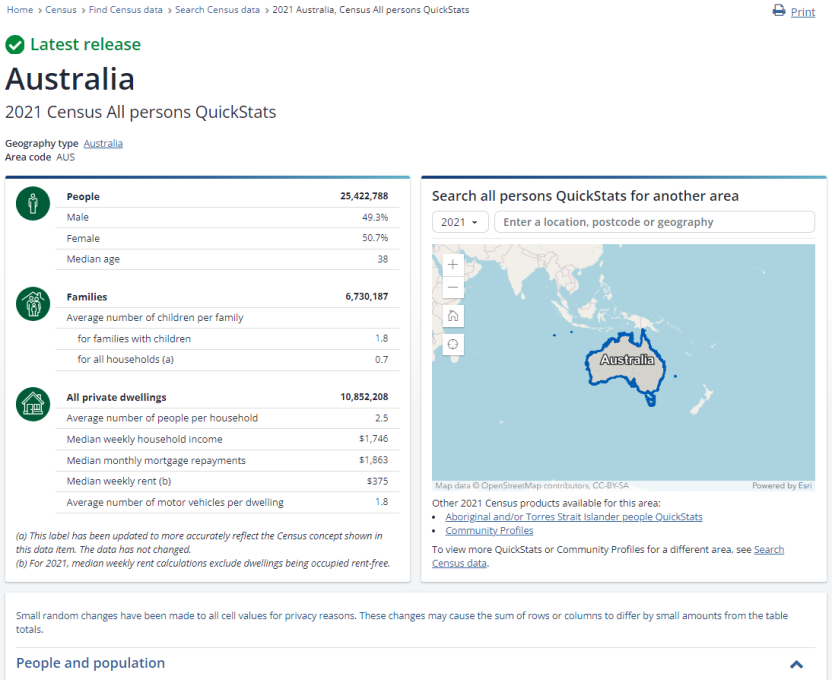| Born in selected country of birth | Born overseas | Born in Australia | Total |
|---|---|---|---|
| This total counts the people who stated they were born in the selected country. | This total counts people who stated they were born overseas and includes people counted in the ‘born in the selected country of birth’ column. | This total counts people who stated they were born in Australia. This includes the Australian External Territories of Christmas Island, Cocos (Keeling) Islands, Norfolk Island and the Jervis Bay Territory. | This total counts all people in the selected area. It includes people who did not state a country of birth. |
QuickStats
Overview
QuickStats are a simple way to understand an area at a glance. They provide a summary of an area including demographics and tables on key characteristics of the people living in the area, their families and their dwellings.
QuickStats data is based on place of usual residence. For a selected area, Census data is grouped into categories and displayed in tables and compared to the state or territory and national data.
The categories are:
- Persons – including age, education, language, ancestry, religious affiliation, health, Defence Force service and employment of people in the selected area.
- Families – including family composition, single parent families and family income of the selected area.
- Dwellings – including the structure and type of dwellings, number of bedrooms, household income, mortgage and rent payments and number of registered vehicles in the selected area.
Image

Description
Small random adjustments have been made to all cell values to protect the confidentiality of respondents. These adjustments may cause the sum of rows or columns to differ by small amounts from table totals.
For more information on the confidentiality of data, the 2021 Census Privacy Statement or introduced random error, refer to Confidentiality.
Where to find QuickStats
QuickStats can be found by using the Search Census data tool. This tool is in the 'Find Census data tile', on the Census homepage.
The Search Census data tool provides you with different ways to find data for a selected area, including QuickStats and Community Profiles. Using one of the options, search by Census year and area of interest to see links to QuickStats for the area.
For more information about how to use Search Census data, see Search Census data user guide.
Types of QuickStats
There are three types of QuickStats.
All persons QuickStats
All person QuickStats provides:
- summary information about people, families and dwellings for a selected area
- area data compared with the state or territory and national data
- data from 2001 onwards
- data on all geographies down to Statistical Area Level 1.
To find a list of the All person QuickStats topics, see the 2021 Census product release guide.
Aboriginal and Torres Strait Islander people QuickStats
This QuickStats provides information about Aboriginal and Torres Strait Islander people and dwellings. Aboriginal and Torres Strait Islander QuickStats are available for the following geographies:
- Australia
- State/Territory
- Statistical Areas Level 4, 3, and 2
- Greater Capital City Statistical Areas
- Indigenous Regions
- Indigenous Areas
- Indigenous Locations.
Aboriginal and Torres Strait Islander QuickStats are available from 2016 onwards.
To find a list of the Aboriginal and Torres Strait Islander people QuickStats topics, see the 2021 Census product release guide.
Country of birth QuickStats
Country of birth QuickStats provides summary characteristics of people who were born overseas. It includes data on the person, their families and dwellings in which they live. This data is available for the:
- top 53 countries of birth in 2011
- top 107 countries of birth in 2016
- top 100 countries of birth in 2021.
Country of birth QuickStats are available for the following geographies:
- Australia
- State and Territories
- Greater Capital City Statistical Areas.
While all the top countries are available for selection, when combined with certain geographies no data will be available due to low counts. Once a country of birth has been selected, the user is prompted to select a geography. This list will not include any low count areas.
To find a list of the Country of birth QuickStats topics, see the 2021 Census product release guide.
Understanding Country of birth QuickStats tables
The countries available in this search are determined by the count of persons who report being born in that country. Data on families and households is determined by the responses of the usual residents who were present in the household on Census Night.